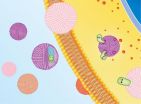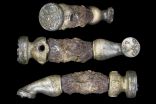(Press-News.org) High-resolution cryo-electron microscopy has now revealed in unprecedented detail the structural changes in the bacterial ribosome which results in resistance to the antibiotic erythromycin.
Multiresistant bacterial pathogens that are insensitive to virtually all available antibiotics are one of the major public-health challenges of our time. The question of how resistance to various antibiotics develops is the focus of research being carried out by Ludwig-Maximilians-Universitaet (LMU) in Munich biochemist Daniel Wilson and his colleagues. As they report in the journal Molecular Cell, he and his team have used high-resolution cryo-electron microscopy to obtain novel insights into the ultrastructural changes in an intracellular machine associated with the acquisition of resistance to the antibiotic erythromycin. "A better understanding of this mechanism is an important step towards the development of new and more potent antibiotics," Wilson says.
Erythromycin targets bacterial ribosomes – the nanomachine responsible for the translation of messenger RNA (mRNA) sequences into protein – thus preventing synthesis of the proteins required for continued growth and survival. Bacteria can become resistant to the antibiotic either as the result of a spontaneous mutation or by picking up an appropriate "resistance gene" (which codes for a protein that confers resistance) from another bacterium via genetic exchange. However, as Wilson explains: "The genes necessary for resistance are often activated only when required (i.e., when the antibiotic is present in the environment), and so-called leader or signal peptides play an important role in this process." The leader peptides regulate the expression of the downstream resistance gene in response to the presence of the drug. When the drug is present, it binds within the tunnel of the ribosome and interacts with the translating leader peptide to stall protein synthesis. The drug-induced stalling allows for a change in the structural conformation of the mRNA, which in turn, unmasks a ribosome-binding site downstream, enabling the nucleotide sequence that encodes the resistance factor itself to be translated.
Diverse ways of gumming up the works
"Exactly how the interaction between antibiotic and leader peptides occurs at the structural level, so as to cause the ribosome to stall, has remained unclear," Wilson says. The researchers had previously shown that the signal peptide encoded by the ermBL mRNA does not interact directly with erythromycin. Instead, the signal peptide adopts a specific conformation in the presence of the antibiotic, which blocks and inhibits the active center of the ribosome, thus accounting for the premature stop. "Since there are other signal peptides apart from the ErmBL leader, we were interested in finding out whether they make use of this same mechanism or have different modes of action," Wilson explains. In their new study, the researchers took advantage of a recent technological breakthrough: "Thanks to the use of a new detector, we were able to increase the resolution of our structures from 4.5 Å to 3.5 Å, which makes previously hidden details visible," says Wilson.
The new analyses revealed that the ErmCL leader peptide employs quite a different mechanism to signal the presence of the antibiotic. Unlike its ErmBL counterpart, the ErmCL signal peptide interacts directly with the antibiotic. As a consequence, at a certain point during translation, the conformation of the ribosome's active site is distorted in such a way that further elongation of the nascent peptide becomes impossible. Wilson is convinced that a thorough understanding of such antibiotic-sensing mechanisms will stimulate the development of more effective antibiotics in the future. He and his group now plan to enhance still further the resolution attainable with their cryo-electron microscope, and will then use it to investigate the structures of ribosomes that have been brought to a halt by other chemical agents.
INFORMATION: END
Antibiotic resistance: Bacterial defense policies
2014-10-14
ELSE PRESS RELEASES FROM THIS DATE:
Scientists identify potential cause for 40 percent of pre-term births
2014-10-14
Scientists from Queen Mary University of London (QMUL) and UCL (University College London) have identified what they believe could be a cause of pre-term premature rupture of the fetal membrane (PPROM), which accounts for 40 per cent of pre-term births, and is the main reason for infant death world-wide.
The researchers, whose work was funded by the charity Wellbeing of Women, used bioengineering techniques to test the effect of repetitive stretch on tissues of the amniotic membrane which surrounds and protects the baby prior to birth.
They found that stretching of the ...
Balancing renewable energy costs
2014-10-14
New York | Heidelberg, 13 October 2014 Increasing reliance on renewable energies is the way to achieve greater CO2 emission sustainability and energy independence. As such energies are yet only available intermittently and energy cannot be stored easily, most countries aim to combine several energy sources. In a new study in EPJ Plus, French scientists have come up with an open source simulation method to calculate the actual cost of relying on a combination of electricity sources. Bernard Bonin from the Atomic Energy Research Centre CEA Saclay, France, and colleagues demonstrate ...
Ultra-fast charging batteries that can be 70 percent recharged in just 2 minutes
2014-10-14
Scientists from Nanyang Technological University (NTU Singapore) have developed a new battery that can be recharged up to 70 per cent in only 2 minutes. The battery will also have a longer lifespan of over 20 years.
Expected to be the next big thing in battery technology, this breakthrough has a wide-ranging impact on many industries, especially for electric vehicles which are currently inhibited by long recharge times of over 4 hours and the limited lifespan of batteries.
This next generation of lithium-ion batteries will enable electric vehicles to charge 20 times ...
Older women more likely to have multiple health conditions
2014-10-14
In the context of an aging population, the number of cases of people with multimorbidity, or multiple health conditions, is increasing, creating significant healthcare challenges. Now, the first comprehensive systematic review in this field has found higher levels of multimorbidity in women. Equally as importantly, it has revealed the poor quality of evidence on this increasingly critical area of healthcare.
The review's main author, Professor Jose M Valderas, NIHR Clinician Scientist of the University of Exeter Medical School, is calling for better quality research to ...
Bio-inspired 'nano-cocoons' offer targeted drug delivery against cancer cells
2014-10-14
Biomedical engineering researchers have developed a drug delivery system consisting of nanoscale "cocoons" made of DNA that target cancer cells and trick the cells into absorbing the cocoon before unleashing anticancer drugs. The work was done by researchers at North Carolina State University and the University of North Carolina at Chapel Hill.
"This drug delivery system is DNA-based, which means it is biocompatible and less toxic to patients than systems that use synthetic materials," says Dr. Zhen Gu, senior author of a paper on the work and an assistant professor in ...
Cushing's syndrome: LCSB researchers characterize a new tumor syndrome
2014-10-14
Scientists at the Luxembourg Centre for Systems Biomedicine (LCSB) of the University of Luxembourg have published their findings that mutations in a gene known as "ARMC5" promote the growth of benign tumours in the adrenal glands and on the meninges: ARMC5 appears to belong to the group of so-called tumour suppressor genes. It is the first time in years that scientists have characterized such a gene.
The ARMC5 gene was discovered by independent workgroups studying benign tumours – so-called adrenal adenomas – in connection with Cushing's syndrome. In this ...
University of Leicester archaeologists discover bronze remains of Iron Age chariot
2014-10-14
University of Leicester archaeologists have made a "once-in-a-career" discovery of the decorated bronze remains of an Iron Age chariot.
A team from the University's School of Archaeology and Ancient History has unearthed a hoard of rare bronze fittings from a 2nd or 3rd century BC chariot which appears to have been buried as a religious offering.
The archaeologists found the remains during their ongoing excavation of the Burrough Hill Iron Age hillfort, near Melton Mowbray, Leicestershire.
The School has led a 5-year project there since 2010, giving archaeology students ...
Disputed theory on Parkinson's origin strengthened
2014-10-14
Parkinson's disease is strongly linked to the degeneration of the brain's movement center. In the last decade, the question of where the disease begins has led researchers to a different part of the human anatomy. In 2003, the German neuropathologist Heiko Braak presented a theory suggesting that the disease begins in the gut and spreads to the brain. The idea has since, despite vocal critics, gained a lot of ground. Researchers at Lund University in Sweden now present the first direct evidence that the disease can actually migrate from the gut to the brain.
The so-called ...
Magnetic superconductor: Strange bedfellows
2014-10-14
Chemists at Ludwig-Maximilias-Universitaet (LMU) in Munich have synthesized a ferromagnetic superconducting compound that is amenable to chemical modification, opening the route to detailed studies of this rare combination of physical properties.
Superconductivity and ferromagnetism – the "normal" form of magnetism, such as that found in the familiar horseshoe magnet – are like chalk and cheese: They generally don't go together. Ferromagnets are magnetic because the parallel alignment of adjacent electron spins in the iron atoms generates a strong internal ...
Rising sea levels of 1.8 meters in worst-case scenario
2014-10-14
The climate is getting warmer, the ice sheets are melting and sea levels are rising – but how much? The report of the UN's Intergovernmental Panel on Climate Change (IPCC) in 2013 was based on the best available estimates of future sea levels, but the panel was not able to come up with an upper limit for sea level rise within this century. Now researchers from the Niels Bohr Institute and their colleagues have calculated the risk for a worst-case scenario. The results indicate that at worst, the sea level would rise a maximum of 1.8 meters. The results are published ...



